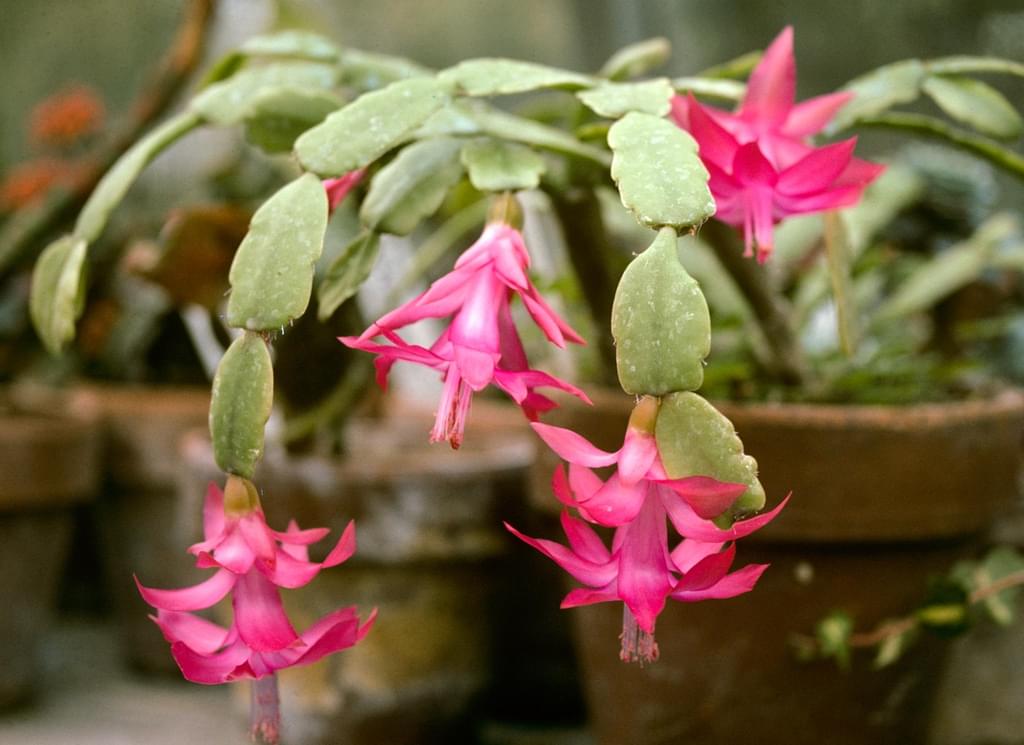You don’t typically think of cacti blooming at Christmas time, but the Christmas and Thanksgiving cacti offers exotic flowers in many different colors during the holiday season. These cacti are different than typical cacti because they are thorn-free. There are actually different types of holiday cacti named for the time they bloom: Easter, Thanksgiving and Christmas. The Thanksgiving cactus typically starts blooming in late fall while Christmas cactus is around a month later. An Easter cactus starts producing flower buds in February. Thanksgiving and Christmas cactus are the most commonly seen and are often sold as “Christmas cacti” because they look so similar. To determine whether you have a Thanksgiving or Christmas kind, will depend on the edges of the leaves. Christmas cacti have smooth, round edges while Thanksgiving cacti have pointy, jagged ones.
Holiday cacti were developed from species of Schlumbergera, a tree dwelling cactus native to the tropical rainforests of Brazil. In the wild they would grow propped between tree branches or in rock crevices, absorbing nutrients from rain water and decaying leaves that get caught among the roots. As houseplants, they need to be grown in light, well drained potting soil and bright light. Holiday cacti actually bloom best when potbound, so growing them in slightly smaller containers is okay.
As for the care of holiday cacti, keeping them evenly moist is important. They do not do well in wet soils and will rot if frequently overwatered. A good rule of thumb for watering these plants is when the top inch of their potting soil appears dry and the container feels light when lifted. Add water until it begins to drain out of the bottom of the pot and allow the plant to drain for a few minutes. If your container has a saucer underneath, be sure to pour out any excess water after each watering. Frequency of watering and fertilizing will vary depending on the time of year. Plants are actively growing from spring through fall, so they should be watered more frequently and fertilized with a water soluble fertilizer every couple of weeks. Since they are tropical plants, they prefer temperatures between 60 and 80 degrees. You can place them outdoors in light shade after the chance of frost in the spring has passed. When the temperature drops in the fall, you will want to transition them back indoors, especially before the chance of frost or freezing temperatures.
The biggest problem or complaint when growing holiday cacti is trouble getting them to rebloom. Failure to rebloom can be caused by sudden change in temperatures or moisture, or exposure to light at the wrong time. These plants are considered short day plants, meaning they will only begin to form flower buds when exposed to over 13 hours of continuous darkness each night. Any light that interrupts this continuous dark period can slow or stop flower formation. Even light from a street lamp or car headlights can stop flower formation. Around October, our nights begin to reach 13 hours. This is when you would want to put your holiday cacti in a location that stays dark all night. I often put mine in a spare bedroom where the lights are rarely turned on. As flower buds begin to form, you will see them at the tips of each branch.
Another common problem is when flower buds form but fall off before opening. If the plant dries out or is exposed to very warm or very cool temperatures (over 90 or under 50 degrees) after flowers buds form, they will often drop off or fail to open. Avoid drastic changes in temperatures and moisture to prevent flower buds from falling off before opening.
Another tip about Holiday cacti is that they are very easy to root. Collect any leaf segments that break off or cut some off and stick into a small container of potting soil. You can also put them in a small cup of water until roots form and then transfer into a container of potting soil. They will root within a few weeks. It makes a great way to grow some holiday cacti to share with family and friends during the holidays.
Jessica Strickland is an Agriculture Extension Agent, specializing in horticulture for North Carolina Cooperative Extension in Wayne County.

(Photo Credit: plants.ces.ncsu.edu)

